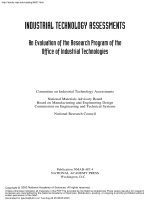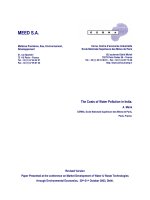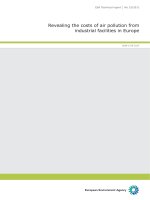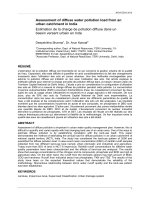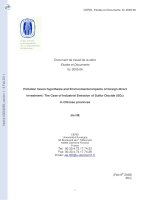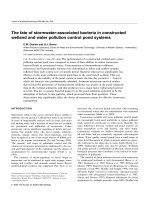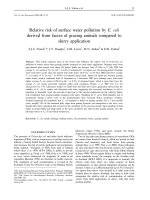Hidden Consequences: The costs of industrial water pollution on people, planet and profit potx
Bạn đang xem bản rút gọn của tài liệu. Xem và tải ngay bản đầy đủ của tài liệu tại đây (6.21 MB, 80 trang )
The costs of industrial water pollution
on people, planet and profit
Hidden
Consequences
Executive Summary 5
Section 1 Rescuing our iconic rivers 9
Case Study: Thailand. The Chao Phraya River 10
Case Study: Russia. The Neva River 14
Case Study: The Philippines. The Marilao River System 18
Case Study: China. The Yangtze River 22
Section 2 Learning from our past mistakes 27
Case Study: The ‘Swiss Toxic Dumps’
The cost of cleaning up Swiss landfill sites 30
Case Study: PCB contamination of the Hudson River in the US 38
Case Study: Polluted sediments in the Dutch Delta Cost
analysis of efforts to clean up sediments contaminated
with hazardous chemicals 42
Case Study: Chemko Strážske’s persistent
PCBs in the Laborec River in Slovakia 50
Section 3 A ‘Toxic-Free Future’ – Providing a blueprint
towards ‘zero discharge’ of hazardous chemicals 59
Greenpeace demands 66
Footnotes 68
image A hidden pipe,
only visible at low tide,
discharges water from a
textile factory into canals
only 1 km from the Chao
Phraya river in Bangkok,
Thailand.
Published by
Greenpeace International
Ottho Heldringstraat 5
1066 AZ Amsterdam
The Netherlands
greenpeace.org
Note to the reader
Throughout this report we refer to the terms ‘Global North’ and ‘Global South’ to describe two distinct groups of countries.
The term ‘Global South’ is used to describe developing and emerging countries, including those facing the challenges of
often rapid industrial development or industrial restructuring, such as Russia. Most of the Global South is located in South
and Central America, Asia and Africa. Within this report this term refers specifically to case studies located within a group of
countries including China, Thailand, the Philippines and Russia.
The term ‘Global North’ is used for developed countries, predominantly located in North America and Europe, with high
human development, according to the United Nations Human Development Index.* Most, but not all, of these countries are
located in the northern hemisphere. Within this report this term refers specifically to case studies located within a group of
countries including the USA, Switzerland, the Netherlands and Slovakia.
* United Nations Development Programme (UNDP). (2005). Human Development Report 2005. International cooperation at a
crossroads. Aid, trade and security in an unequal world. Available at: />For more information contact:
Acknowledgements:
We would like to thank the following
people who contributed to the creation
of this report and the accompanying
Policy Q&A. If we have forgotten
anyone, they know that that our
gratitude is also extended to them:
Orana Chandrasiri, Madeleine Cobbing,
Tommy Crawford, Peter Donath,
Steve Erwood, Martin Forter,
Ken Geiser, Elaine Hill, Martin Hojsík,
Gao Jing, Daniel Kessler, Daniel Kramb,
Alexey Kiselev, Aldert van der Kooij,
Veronica Lee, Cameron McColgan,
John Novis, Ply Pirom, Rick Reibstein,
Melissa Shinn, Ilze Smit, Mary Taylor,
Beverly Thorpe, Diana Guio Torres,
Kateřina Věntusová, Munung Wang,
Yixiu Wu & Matthias Wüthrich
Designed by:
Arc Communications
JN 361
Contents
© GREENPEACE / JOHN NOVIS
Greenpeace
International
Hidden Consequences
The costs of industrial
water pollution on people,
planet and profit
Hidden Consequences: The costs of industrial water pollution on people, planet and profit 3
4 Hidden Consequences: The costs of industrial water pollution on people, planet and profit
© LU GUANG / GREENPEACE
image In Gurao,
China, the economy is
centred around textile
production. Greenpeace
has documented the
effects this has had on
the community.
Hidden Consequences: The costs of industrial water pollution on people, planet and profit 5
Executive
Summary
Greenpeace
International
Hidden Consequences
The costs of industrial
water pollution on people,
planet and profit
Industrial pollution is a severe threat to water
resources around the world, particularly in
the Global South where the view prevails that
pollution is the price to pay for progress. This
view is usually associated with the ideas that
dealing with pollution is too costly, that pollution
prevention is too difficult and impractical, and
that environmental and social effects can be
dealt with in the future.
To make matters worse, there is also a general
misconception that wastewater treatment
plants can eventually deal with all water
pollutants, whatever their toxicity.
This short-term view has resulted in the
widespread dumping of undisclosed and often
hazardous chemicals into water. However,
when substances with persistent and/or
bioaccumulative
1
properties remain undetected
or ignored in the aquatic environment, long-
lasting and irreversible environmental and health
problems can result.
‘Zero discharge’
The only way to address these hidden dangers in our
water is through a preventative approach: Taking action to
phase out the use and discharge of hazardous chemicals,
rather than attempting to control the damage with end-
of-pipe treatment methods. Accordingly, Greenpeace is
calling for governments to adopt a political commitment
to ‘zero discharge’
2
of all hazardous chemicals within one
generation, based on the precautionary principle and a
preventative approach to chemicals management.
This commitment must be matched with an
implementation plan containing short-term targets,
a dynamic list of priority hazardous substances requiring
immediate action
3
, and a publicly available register of
data about discharge emissions and losses of hazardous
substances, such as a Pollutant Release and Transfer
Register (PRTR)
4
.
Our call for ‘zero discharge’ is built upon three decades
of exposing and addressing the problem of hazardous
chemicals. However, rapid industrialisation is now taking
place in many parts of the Global South, with seemingly
little regard for the painful lessons learnt in the Global North
– where the pollution caused by hazardous substances
has generated enormous economic, environmental and
social costs.
Executive
Summary
Learning lessons from
the Global North
Case studies from the Global North show the extent to
which persistent and bioaccumulative substances have
contaminated entire regions. They also show the immense
difficulties – technical, economic and political – of cleaning
up these hazardous chemicals after release, including
the very high expense of restoration programmes and the
impossibility of total decontamination.
Worse still, the largely unquantifiable costs to human
health, the environment and to local economies are
rarely considered or compensated. Many of these effects
are irreversible, while the effects beyond the region
concerned are impossible to calculate. For persistent and
bioaccumulative substances these effects can be global,
as they can be transported far beyond their source via
ocean currents and atmospheric deposition, and they
have even accumulated in the polar regions of the Earth.
In East Asia, Southeast Asia and other parts of the world
where industrialisation is booming, there is a danger
that expenditure on even basic environmental measures
– let alone the avoidance of hazardous substances
through substitution – could be seen as an unnecessary
impediment to economic growth. The case studies from
the Global North show that attempts to ‘save money’
by opting for the cheapest ways to use and dispose of
hazardous chemicals in the short term can ultimately
translate into extremely high costs and losses in the future.
These costs then have to be borne by someone, and this
is either the companies concerned or the taxpayer – often
both.
Polluting in the pursuit of profit can prove to be an
expensive strategy for industry in the long run. The Swiss
chemical industry and General Electric in the US have both
been held accountable for subsequent clean-up costs.
However, pinning responsibility onto the polluter is not
always straightforward, such as in the case of the Laborec
River in Slovakia. If financial liability cannot be established,
or if the polluter is no longer around, it is the state, and
therefore the taxpayer, who is left with the clean-up bill.
In a large river basin, the polluters can be so numerous
and widely spread that it is not possible to hold them liable
for clean-up of the enormous pollution problems caused
downstream, as is the case with the delta formed by the
confluence of the Rhine, Meuse and Scheldt rivers in the
Netherlands and Belgium. The Rhine-Meuse delta problem
is not unique – the world has many heavily industrialised
water basins. The Yangtze and the Pearl River Delta
in China, the Great Lakes in the US and the Riachuelo
River basin in Buenos Aires face similar difficulties, with
high concentrations of persistent contaminants in the
sediments of the rivers and their harbours.
The opportunity
If we fail to learn from the mistakes of the past, then we
are doomed to repeat them. This is especially the case
in those regions of the world where much chemical and
manufacturing production has now relocated – namely
Asia and the wider Global South. Policy makers in these
regions have the opportunity to avoid making some of the
same grave mistakes that were made in Global North, and
‘leapfrog’ over the conventional approach of waste and
wastewater end-of-pipe treatment to focus on prevention
first.
5
A precautionary approach would help protect their
waters – and the livelihoods of all those who rely on those
waters – both now and for future generations.
The message could not be clearer. Governments have
a choice. Should they expose their citizens and the
environment to hazardous toxic pollution, and condemn
future generations to pay for the management of
contaminated sediments, whose full and final costs are
incalculable? Or should they instead commit to a ‘Toxic-
Free Future’, and take precautionary action to support
truly sustainable innovation and progressively eliminate the
use and release of hazardous substances down to ‘zero
discharge’?
6 Hidden Consequences: The costs of industrial water pollution on people, planet and profit
Hidden Consequences: The costs of industrial water pollution on people, planet and profit 7
Greenpeace
International
Hidden Consequences
The costs of industrial
water pollution on people,
planet and profit
Executive
Summary
© LU GUANG / GREENPEACE
image A Greenpeace
campaigner takes a
water sample from
a polluted river near
Dadun Village, Xintang,
Zengcheng, in China.
8 Hidden Consequences: The costs of industrial water pollution on people, planet and profit
01
© JOHN NOVIS / GREENPEACE
image Food is sold
from a boat in a floating
market in the Taling
Chan canal in Bangkok.
Hidden Consequences: The costs of industrial water pollution on people, planet and profit 9
Rescuing our
iconic rivers
01
Greenpeace
International
Hidden Consequences
The costs of industrial
water pollution on people,
planet and profit
Section
one
An opportunity to act, before
it’s too late
Rivers provide a lifeline for the communities
through which they flow and for the cities that
swell on their banks. They supply vital and life-
sustaining resources, including drinking water,
crop irrigation, and food. They also serve as
a critical support system for industrial activity,
providing water for many manufacturing or
cooling processes.
It is this industrial activity that often has a
hidden, darker side.
This section portrays four iconic rivers in the Global South,
which are increasingly being destroyed by industrial activity
and the use of hazardous substances. These rivers are the
Chao Phraya in Thailand, the Neva in Russia, the Marilao
River System in the Philippines and the Yangtze in China.
Hazardous industrial chemicals can be found in all of
these rivers. Many of these substances are persistent and
can gradually accumulate in sediments and in the food
chain, impacting upon critical resources, such as water
for agriculture and drinking water, and contaminating
wildlife and entire ecosystems. This, in turn, can cause
long-term, irreversible damage to people, the environment,
and the wider economy. Worse still, this damage has the
potential to spread far beyond the boundaries of the rivers
themselves. For example, when these rivers discharge into
seas and bays, the pollutants they carry are transported
even further – affecting coastal and marine environments
and resources.
The evidence of pollution by persistent hazardous
substances contained within this section shows that
industrial production around these rivers is taking place
with little regard for the ecological and human health
consequences. This is happening despite the fact that
industries from the Global North have had to learn difficult
lessons about the serious repercussions of short-term
thinking (see Section 2) and that avoiding the use and
discharge of hazardous substances is both possible and
more cost-effective (see Section 3).
It is not too late to act. It is still possible to limit and prevent
future damage to these – and many other rivers – but new
rules and responsibilities are required. It is clear that the
use of pollution control or wastewater treatment does not
deal effectively with all hazardous substances, and only
postpones the need for more effective measures. The
problem has to be tackled at its source. This means that
in order to eliminate and prevent discharges of hazardous
chemicals into the environment, all their uses need to be
phased out – throughout the chain of production. To be
effective, this action needs to be based on knowledge,
which in this case requires the quantities of hazardous
substances used and discharged to be reported and
monitored, with full availability of data to the public.
The time to act is now. As the following four case studies
demonstrate, there is an urgent need to eliminate the use
and discharge of hazardous substances by industry, to
rescue these precious rivers and protect the livelihoods of
all those who rely upon them.
The Chao Phraya River
The Chao Phraya is the most important river system in
Thailand. Comprising four major, upstream tributaries, the
river flows southwards through Bangkok before emptying
into the Gulf of Thailand.
6
In 2009, the population of the
Chao Phraya River basin was nearly 13 million people.
7
Due to its profound cultural and historical significance,
many revere the Chao Phraya as the ‘heart’ of Thailand,
and the river basin is widely regarded as the most
important food production area in the country.
8
In addition,
much of the upstream river and associated wetlands are
very rich in wildlife – the Chao Phraya and its tributaries
boast over 300 species of fish
9
, for example.
The river basin is also vital to the country’s economy.
Over 30,000 industrial facilities are located in the Chao
Phraya basin
10
, including pulp and paper, textile and
dyeing, rubber and food production industries. However,
the ongoing industrialisation competes with traditional
uses such as fishing or water for agriculture, and also with
the provision of safe drinking water to Thailand’s biggest
metropolis – Bangkok.
11
The river currently suffers from growing pollution, and the
water quality in its lower reach – where most of the industry
is located
12
– has been classified as ‘deteriorated’, based
on the Thai water quality index.
13
Yet despite significant
quantities of hazardous chemicals being manufactured
and in use
14
, little is known about the releases or about the
extent of pollution caused by hazardous substances from
industrial sources. This is true not only for the Chao Phraya
River, the groundwater, ecosystems and agricultural land
in the basin, but also for other river basins in Thailand.
The absence of good data gathering systems and data
management problems
15
are partly to blame for this.
However, a number of specific studies in the Chao
Phraya basin have provided clear evidence that certain
effluents containing persistent, bioaccumulative and toxic
chemicals, are being discharged by industry and are
contaminating the river basin. For example, a study by
Greenpeace in 2003 showed the presence of many toxic
metals and organic pollutants in the sediments of canals
and in effluents discharged into them at an industrial estate
at Samut Prakarn.
16
Substances including copper, lead,
nickel and zinc were found in the sediments of one canal at
between 50 and 100 times the background levels.
Case Study: Thailand
Phthalate esters and nonylphenols – both toxic
substances – were also identified.
Industrial chemicals known as perfluorooctane sulfonate
(PFOS) and perfluorooctonoic acid (PFOA) have also
been measured in a 2009 study in water samples from
the Chao Phraya River and in wastewater discharges
from treatment plants at industrial estates.
17
One
sampling point was near the mouth of the Chao Phraya
at the Gulf of Thailand. Here, the calculated loads of
these substances entering the Gulf via the Chao Phraya
had the potential to enter the food chain, given the
’important food sources‘ in the Gulf. There was also
indication of tap water contamination at some locations.
Both chemicals have been shown to disrupt hormone
systems and are now widely found in humans.
18
Although the studies discussed above are not designed
to provide a comprehensive overview of the situation,
they nonetheless demonstrate industrial contamination
of water and sediments in parts of the Chao Phraya
and its interconnecting canals. There is no reason to
presume that these are isolated or unusual instances,
but more investigation is needed in order to form
a clearer picture of the situation. The potential for
accumulation of persistent chemicals in the environment
and bioaccumulation in wildlife and humans can already
be seen, even if the scale of the problem so far is not
fully clear.
There is an urgent need to establish the extent of the
problem and develop appropriate solutions – including
the establishment of a priority substance list – with the
aim of eventually eliminating all releases of hazardous
substances. In this respect, a precautionary and
sustainable approach to the management of hazardous
substances is required, starting with more transparency
and publicly accessible data.
Time is short. The fact that many of the hazardous
substances identified in the Chao Phraya and in the sea
water off the coast of Thailand
19
are banned in other
more developed markets, or have been prioritised for
elimination by the Stockholm Convention on Persistent
Organic Pollutants, should be a wake-up call to the
authorities to start addressing this problem now.
10 Hidden Consequences: The costs of industrial water pollution on people, planet and profit
Hidden Consequences: The costs of industrial water pollution on people, planet and profit 11
Section
one
‘About 30 years ago, when I was a kid, there
were only orchards in this area. People
made sugar, and rowing boats came in and
out to transport the sugar. I used to swim
in the canal. My parents and neighbours
fished in this canal. We caught fish and huge
river prawns that are now very expensive.
We could catch plenty of them. We didn’t
sell them but caught enough for our
consumption.
‘Around 1973, factories began springing
up. At first there was only a corn syrup
factory and that didn’t really cause so much
pollution. People around here began to
sell their land to factory builders. Orchards
disappeared and were replaced by more and
more factories. When the garment bleach
and dyeing factory came here, the water got
worse.
‘There are about five factories of this kind
today, dumping their wastewater into both
canals. They usually do that during the night.
In the evening, I can see the water turns
dark and the foul odour gets really strong
at dawn. We have petitioned the provincial
office, but it has fallen on deaf ears. The
factories don’t care about us and don’t
tell us anything, but what they do to my
community is so severe.
‘We should have the right to know what kind
of substances the factories are using and
how much pollution they release and how
dangerous it is. I want someone to work on
it. It should be the beginning of new things.’
Boonsong Nakarak – a resident of a community
living by the Klong-Samrong canal and the Klong-
Mahawong canal, which connect to the Chao Phraya
River, Samut Prakarn province
© JOHN NOVIS / GREENPEACE
image A water treatment pond
of a bleaching and dyeing factory
near the Samrong Canal, in the
lower part of the Chao Phraya
River basin. The waste water
released from this textile factory
has many different colours from
dyeing, and a chemical smell.
Greenpeace
International
Hidden Consequences
The costs of industrial
water pollution on people,
planet and profit
Section
one
12 Hidden Consequences: The costs of industrial water pollution on people, planet and profit
© JOHN NOVIS / GREENPEACE
image In many areas from the
upper reach to the middle reach
of the Chao Phraya, water is
extensively used for domestic
consumption. However, it has
been limited to only cleaning
purposes as the water is no
longer drinkable.
Hidden Consequences: The costs of industrial water pollution on people, planet and profit 13
Greenpeace
International
Hidden Consequences
The costs of industrial
water pollution on people,
planet and profit
Section
one
Chao Phraya
The Neva River
The Russian Neva, the third largest river in Europe in terms
of average discharge, supplies St Petersburg and its
5 million inhabitants with all its drinking water.
20
Despite
this critical role, its waters remain largely unprotected from
contamination with hazardous chemicals as a result of
both formal and informal industrial activities.
St Petersburg and its surroundings are home to a large
number of diverse industrial enterprises, including a
substantial concentration of electric and electronic
equipment manufacturers. While the final products
are ‘high tech’, their production uses a wide range of
hazardous chemicals, which generate large quantities
of liquid wastes. In the St Petersburg area, these are
either discharged directly into the Neva River or directed
to one of three large common effluent treatment plants.
The solid waste (sludge) from the treatment plants was,
until recently, sent to landfill.
21
Here the sludge ended up
in disposal pits where it could continue to produce liquid
wastes, which have the potential to pollute surface waters,
groundwater and soil.
One toxic waste landfill in the Neva watershed, Krasny Bor,
receives not only wastewater sludge, but also industrial
organic and inorganic hazardous waste from enterprises
in Leningrad Oblast, including industrial solvents, PCB-
containing equipment, and pesticides.
22
This landfill is the
cause of substantial water contamination with a wide range
of contaminants – including phenols and polychlorinated
biphenyls (PCBs)
23
– and illustrates the failure of traditional
methods of pollution control, as the pollutants simply get
transferred from one medium to another.
In addition, there are many poorer urban areas where
unofficial and unregulated ‘recycling’ of electronic waste
takes place. A common practice is the open burning of
cables, circuit boards and other components in order to
recover traces of precious metals for resale. However,
such activities may also release hazardous chemicals,
including PCBs, brominated flame retardants (BFRs) and
toxic heavy metals.
24,25,26,27
Their release further exposes
humans and the environment to significant quantities of
these substances and adds to the pollution in the Neva
River basin.
An investigation by Greenpeace in 2010 showed the
presence of a variety of toxic metals and persistent
organic chemicals in some industrial effluents, in the
sludge of certain wastewater treatment plants, in river
sediments, and in soils where electronic waste ‘recycling’
had been carried out. The results demonstrated
considerable contamination by industrial substances,
including chemicals with persistent and bioaccumulative
properties.
28
Together, these factors highlight the urgent need for
systematic assessment of industrial pollution of the Neva
and the environs of St Petersburg. Although an official
system for monitoring the water quality in the Neva basin
is in place
29
, only a relatively small range of persistent and
potentially hazardous chemicals are routinely measured
in the surface water by the state agency
30
. As a result,
only limited information on persistent organic pollutants
(POPs) or heavy metal contaminants in the Neva River
and its sediments are available. Similarly, monitoring of
industrial effluents, whether directly discharged into rivers
or sent to treatment plants, is not comprehensive.
31
There
is no disclosure of the data to the public
32
and there is
little incentive for companies to substitute hazardous
chemicals
33
or implement pre-treatment measures
34
.
In order to address the problem of hazardous chemicals,
it is therefore necessary to first identify the sources,
range and quantities of hazardous chemicals being
released into the river basin by industry, and to provide
full public access to this data. As the situation in the Neva
illustrates, pollution is caused by hazardous chemicals at
both ends of a product’s life cycle – in its manufacturing
and its disposal. This demonstrates the urgent need
for a chemical management strategy that is based on a
political commitment to ‘zero discharge’ of all hazardous
substances, including both those present in products, and
those found in industrial releases.
35
14 Hidden Consequences: The costs of industrial water pollution on people, planet and profit
Case Study: Russia
Hidden Consequences: The costs of industrial water pollution on people, planet and profit 15
Greenpeace
International
Hidden Consequences
The costs of industrial
water pollution on people,
planet and profit
Section
one
© IRINA KOVALCHUK/GREENPEACE
image The Slavyanka,
a tributary of the Neva.
The Neva remains
largely unprotected
from contamination
with hazardous
chemicals as a result
of both formal and
informal industrial
activities.
16 Hidden Consequences: The costs of industrial water pollution on people, planet and profit
© GEORGY TIMOFEEV/GREENPEACE
image The
Krasnenkaya
river, a tributary
of the Neva.
Hidden Consequences: The costs of industrial water pollution on people, planet and profit 17
Greenpeace
International
Hidden Consequences
The costs of industrial
water pollution on people,
planet and profit
Section
one
Neva
The Marilao River System
The extensive Marilao River System in the province of
Bulacan, near Manila in the Philippines, now holds the
dubious distinction of being labelled by the Blacksmith
Institute as one of the world’s dirtiest rivers.
36
The report by the Institute points to the high levels of
pollution being due to wastes received from various
sources, including tanneries, gold and precious metals
refineries, a legacy of lead-smelting waste, from numerous
municipal dumpsites, and from small-scale lead recycling
facilities along the river. A monitoring programme for the
Marilao River System – set up in 2008 with the Asian
Development Bank
37
– confirmed the contamination of
the Marilao River System by heavy metals, with the levels
of many exceeding the surface water standards
38
set by
the Department of Environment (DENR-EMB)
39
at one or
more monitoring stations. Furthermore, in a number of
groundwater samples the levels of manganese, zinc, nickel
and cadmium in groundwater exceeded the Philippines
National Drinking Water Standard. At least one of the
groundwater sources sampled was being used as drinking
water by the local community.
40
The monitoring programme report also documents river
sediment samples with levels of metal contaminants –
notably of copper, nickel, mercury and lead – that exceed
the limits set under the US Washington State sediment
standards.
41
This contamination is most likely a result of a
long-term build up of these persistent metal pollutants over
many years.
42
Shellfish and freshwater fish from the Marilao River System,
widely consumed by the population in the area and in
metropolitan Manila, also displayed evidence of metal
contamination, in some cases with levels in excess of
established limits for human consumption.
The report observes a correlation between the monitored
river contamination and the levels of heavy metal pollutants
– manganese, zinc and nickel – that were found in fish.
The report also warns that the heavy metals present
in the edible fish and shellfish can, as a result of their
consumption, potentially bioaccumulate in humans over
the years, leading to the possibility of ‘certain diseases and
ailments’.
43
The need for the rehabilitation of the Marilao, Meycauayan
and Obando rivers has been recognised by authorities
in the Philippines. In 2008, the DENR and the Provincial
Government of Bulacan established the country’s first
Water Quality Management Area (WQMA)
44
, including a
draft 10-year action and implementation plan
45
. However,
while this plan covers the clean-up of the existing
contamination and wastewater treatment for ongoing
discharges, it contains very few concrete measures to
prevent future contamination by addressing the problem
at source and eliminating the actual use of hazardous
chemicals. As the plan stands at the moment, it is
questionable whether it will be able to fully deliver on its
goal of achieving complete control over the source of the
pollution. However, it is clear that any effort undertaken to
clean up the existing damage to the river system will entail
massive costs for the provincial government.
Already, the consequences for the national economy
have been demonstrated by the scale of the estimated
clean-up costs
46
– which are prohibitive in a country such
as the Philippines. Experience from the Global North (see
Section 2) would also suggest that these costs are just
the beginning. In this situation, the authorities are rightly
focusing on controlling the sources of pollution, yet their
proposed plan will not completely eliminate the use and
discharge of hazardous chemicals, such as heavy metals.
There is an urgent need to implement plans for clean
production and to eliminate discharges of hazardous
chemicals into the river basin, with the priority on
substituting the most hazardous substances with safer
alternatives (see Section 3). The creation of a national
Pollution Release and Transfer Register (PRTR), supported
by UNITAR, would be a first step
47
, followed by a more
comprehensive list of priority substances to be tackled
48
and a robust strategy aiming to eliminate all releases of
hazardous chemicals within one generation.
18 Hidden Consequences: The costs of industrial water pollution on people, planet and profit
Case Study: The Philippines
Hidden Consequences: The costs of industrial water pollution on people, planet and profit 19
Greenpeace
International
Hidden Consequences
The costs of industrial
water pollution on people,
planet and profit
Section
one
© JOHN NOVIS / GREENPEACE
image A
Greenpeace
volunteer talks to a
local resident beside
Marilao River in
Bulacan. The river
has been identified
by the DENR as one
of the Philippines’ 50
dead rivers due to
heavy pollution.
20 Hidden Consequences: The costs of industrial water pollution on people, planet and profit
© JOHN JAVELLANA/GREENPEACE
image Workers
operate a machine
that separates various
layers of animal skin to
be processed inside a
tanning facility located in
Meycauayan, Bulacan,
north of Metro Manila.
20 Hidden Consequences: The costs of industrial water pollution on people, planet and profit
21
Greenpeace
International
Hidden Consequences
The costs of industrial
water pollution on people,
planet and profit
Section
xxx
Marilao
Hidden Consequences: The costs of industrial water pollution on people, planet and profit 21
22 Hidden Consequences: The costs of industrial water pollution on people, planet and profit
The Yangtze River
Throughout China’s long history, the Yangtze River basin
has been a centre of cultural and industrial activity.
49
Today, it contributes around 40% of the nation’s GDP
50
,
the equivalent of about $1.5 trillion US dollars
51
.
Commercial activity has prospered; over a billion tons of
cargo passed through Yangtze River ports in 2008
52
, and
these convenient national and international transport links
and abundant water resources also offer vital advantages
to industry. Industrial developments are particularly
concentrated in the Yangtze River Delta region. Major
industries there include raw chemicals and chemical
products, chemical fibres, petroleum refining, coking and
nuclear fuel processing, smelting and pressing of ferrous
metals, transport, electric equipment and machinery,
telecom, textiles, and computers and other electronics.
53
The delta region alone accounts for around one-fifth of
China’s entire economy.
54
It includes 16 cities, among
them Shanghai, whose 20 million people are dependent on
the Yangtze for drinking water
55
.
The river receives around 30 billion tons of wastewater
every year (including domestic sewage), some of it
untreated.
56,57
According to Müller et al (2008), the quantity
of pollutants disposed of into the Yangtze may be ‘one of
the world’s largest’, albeit diluted by the enormous volume
of water in the river.
58
Approximately 15% of the river failed
to meet the standard for use as a drinking water source in
2008.
59
While a great variety of chemicals are inevitably discharged
by industry every day, perhaps the most insidious are the
persistent and bioaccumulative substances. Despite the
dilution factor mentioned above, these substances can
be subsequently re-concentrated back to harmful levels in
sediments and biota.
Inevitably, such chemicals will eventually become
problematic if their discharge is continued. In an interview
with Greenpeace, Dr. Beat Müller of the Swiss Federal
Institute of Aquatic Science and Technology recalled that in
Europe during the 1950s and 60s the attitude that ‘dilution
is the solution to pollution’ had disastrous effects
60
,
as levels of persistent chemicals built up over time in
sediments and wildlife. Existing data suggests that there is
no room for complacency. A range of organic pollutants,
including persistent substances, has already been found in
the Yangtze.
61
Combined with other pollutants, such as increasing
quantities of nutrients from sewage and agriculture
discharging into the estuary and East China Sea, it is
considered that the loads of pollutants in the Yangtze
could have a ‘disastrous effect’ on the estuarine and
marine area.
62
Persistent substances that have the
potential to accumulate in the food chain could have
serious consequences for fisheries in this area.
In a 2010 study, Greenpeace looked at samples of popular
edible fish – wild southern catfish and common carp –
from locations near four major cities along the Yangtze.
Alkylphenols (APs) – a group of persistent hazardous
chemicals with hormone disrupting properties
63,64
– were
recorded in the livers of all but one fish. The results support
the bioaccumulation of APs in the fish species along the
Yangtze and show that APs are widespread in fish along
the Yangtze – with consequences for human exposure
since the two species sampled are commonly eaten.
65
Another persistent industrial chemical, perfluoroctane
sulfonate (PFOS), was also detected in almost all the
samples. The beginnings of long-term build-up of
bioaccumulative and hazardous substances in the Yangtze
River food chain seem very clear
66
; the widespread
pollution by these and other hazardous chemicals released
by industrial processes could undermine the health of the
river and the sustainability of the region’s economy.
Case Study: China
Hidden Consequences: The costs of industrial water pollution on people, planet and profit 23
Greenpeace
International
Hidden Consequences
The costs of industrial
water pollution on people,
planet and profit
In addition to the enormous quantities of wastewater
discharged into the Yangtze River Basin on a daily basis,
industrial accidents can also result in serious additional
pollution. With thousands of chemical enterprises
operating in the Yangtze River Basin, the danger of an
accidental release of hazardous chemicals into waterways
is present for as long as these substances remain in use.
Pollution incidents may have immediate and large-scale
consequences for local communities, ecosystems and
the economy – for example, if drinking water sources are
affected. In one incident in the Yangtze River basin, water
supplies to nearly 1 million people were suspended when
malfunctioning equipment at a fertiliser plant caused
serious river pollution.
67
In another region, a serious
explosion at a chemical factory, which caused five deaths,
released 100 tonnes of benzene and other chemicals, and
lead to the temporary shutdown of tap water supplies for
3.5 million people.
68
It should not be assumed that the Yangtze River has an
unlimited capacity to absorb and dilute industrial pollution.
There is grave concern for the Yangtze River, because of
the sheer scale of the industrial development that is taking
place and because of the huge number of people whose
livelihoods depend upon its waters. Contamination by
hazardous chemicals is already measurable despite the
volume of the river, and is also threatening the East China
Sea. A plan that leads to ‘zero discharge’ of hazardous
substances needs to be urgently implemented in order to
avoid the potentially enormous costs of remediation, and
before China’s rapid economic growth pushes the Yangtze
beyond its ecological limits.
Section
one
‘Many chemical and industrial enterprises
are built along rivers so that they can dump
the waste into water easily. Excessive use
of fertilisers and pesticides also pollute
underground water. The contaminated
water has directly affected soil, crops and
food.’
69
Chen Zhizhou, a health expert with the Cancer
Research Institute affiliated to the Chinese Academy
of Medical Sciences
24 Hidden Consequences: The costs of industrial water pollution on people, planet and profit
‘The river water smells here –
you can’t even use it for bathing,
or else you’ll itch and break out
in little red spots all over your
body. Don’t even think about
drinking this stuff.’
Xie Chunlin, a local fisherman at Yanglingang, Fuqiao, in Taicang
70
© LU GUANG / GREENPEACE
image Families who
fish and drink water from
the Yangtze river have
noticed that the water
has a strange flavour.
They have reported the
worsening pollution and
requested the installation
of tap water for their
village, but years have
passed with no action
being taken.
Hidden Consequences: The costs of industrial water pollution on people, planet and profit 25
Greenpeace
International
Hidden Consequences
The costs of industrial
water pollution on people,
planet and profit
Section
one
Yangtze
